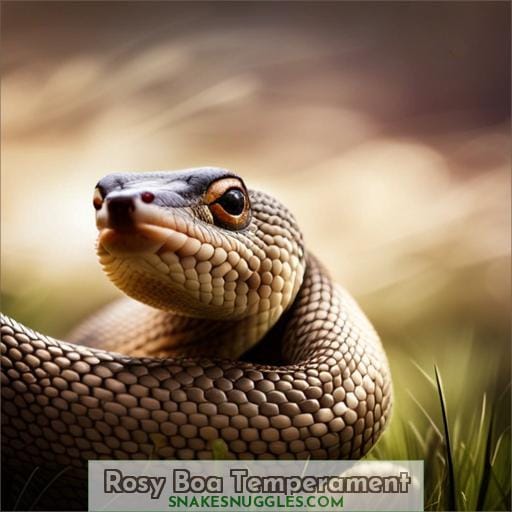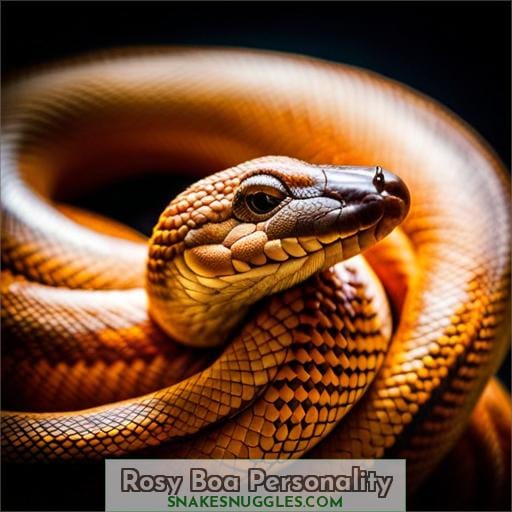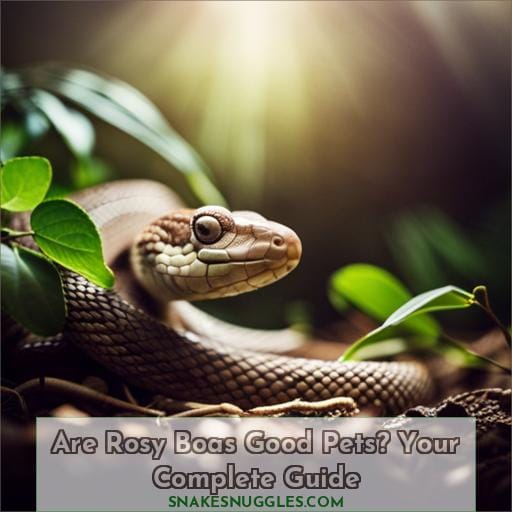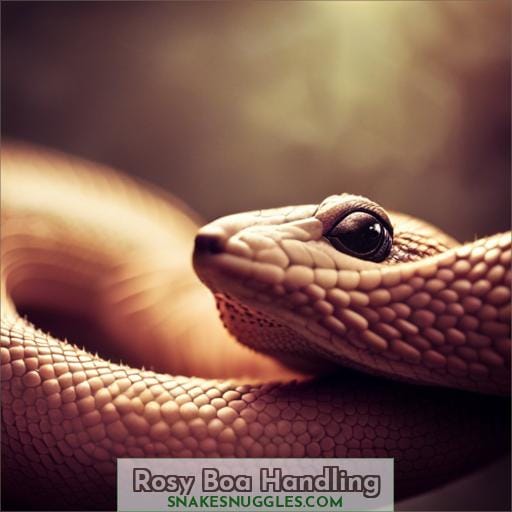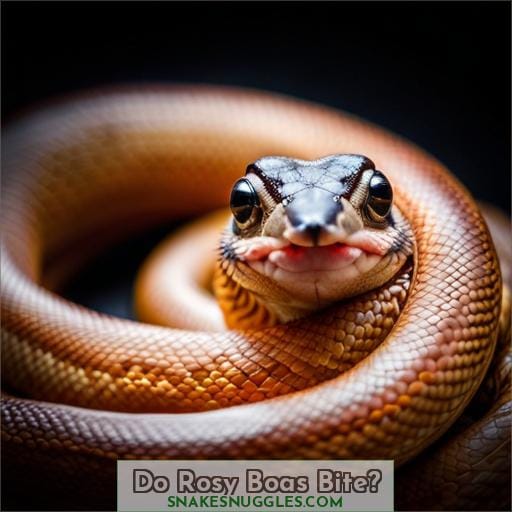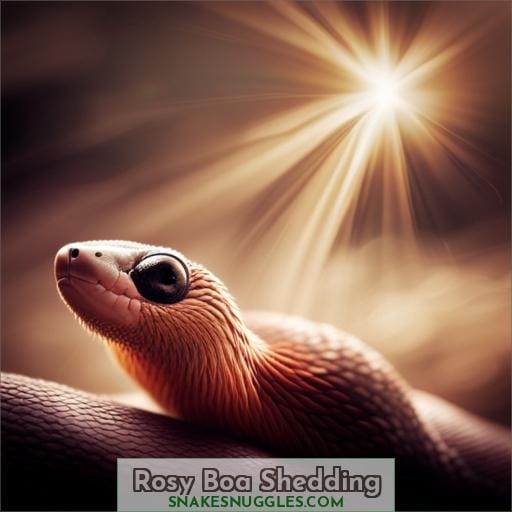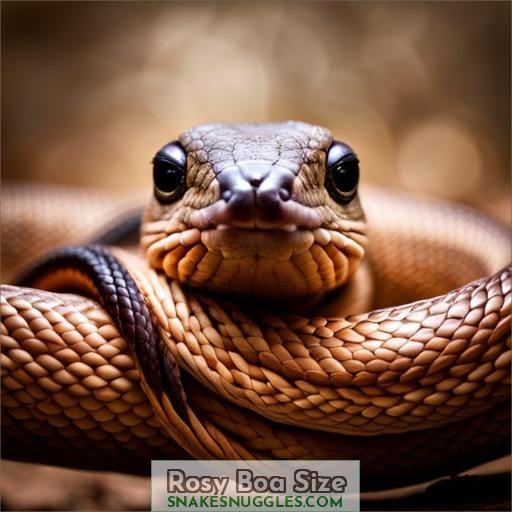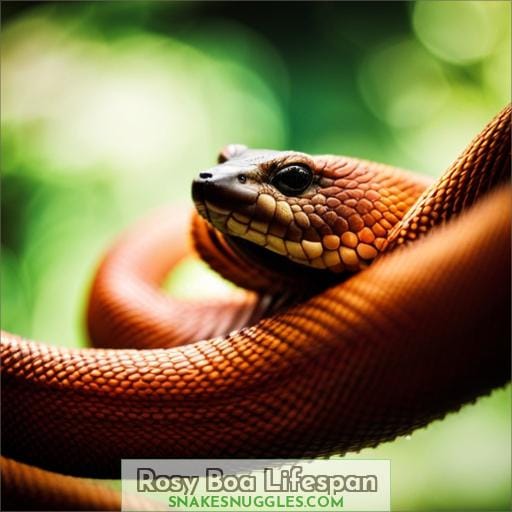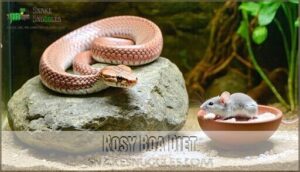This site is supported by our readers. We may earn a commission, at no cost to you, if you purchase through links.

But did you know there’s a smaller, gentler boa that makes an ideal pet?
The rosy boa, with its docile temperament and captivating colors, is perfect for snake enthusiasts of all levels.
Its calm demeanor and manageable size make it an ideal companion for those seeking a captivating and rewarding reptile experience.
In this comprehensive guide, we’ll delve into the rosy boa’s temperament, personality, and care requirements, providing you with all the knowledge you need to provide a nurturing home for this fascinating creature.
Table Of Contents
Key Takeaways
- Rosy boas have a calm, friendly demeanor and are rarely aggressive.
- They are suitable for households with other pets and are relatively easy to handle.
- Rosy boas are active, curious, and gentle snakes with captivating intelligence.
- They can establish territories, engage in courtship rituals, and form bonds with their owners.
Rosy Boa Temperament
Your rosy boa’s temperament is calm and friendly, making it a great choice for a pet snake.
Its docile nature and easygoing demeanor make it an ideal companion for reptile enthusiasts of all experience levels.
Rosy boas aren’t known for aggression and rarely bite, even when provoked.
This gentle temperament extends to their interactions with other animals, making them suitable for households with other pets.
They’re also relatively easy to handle, as they aren’t prone to sudden movements or erratic behavior.
Rosy boas are active and curious creatures, spending their days exploring their environment and seeking out opportunities to bask in the sun or hide under rocks.
They’re also excellent climbers and can scale branches and rocks with ease.
While they aren’t social animals, rosy boas can form bonds with their owners and become quite tame over time.
With regular handling and interaction, they can become accustomed to human presence and even learn to recognize their owner’s voice.
Rosy Boa Personality
Their friendly demeanor makes them delightful companions, earning them a reputation for being gentle and easygoing snakes.
Rosy boas possess a captivating intelligence, utilizing their keen senses to navigate their environment and communicate with each other. They establish territories and engage in courtship rituals, demonstrating complex behaviors that highlight their unique personalities.
During the breeding season, rosy boas engage in elaborate mating displays, intertwining their bodies and performing synchronized movements. Females exhibit nesting behavior, carefully constructing burrows or utilizing existing cavities to lay their eggs.
Once the eggs hatch, the young rosy boas emerge with a remarkable level of independence, showcasing their innate survival instincts.
As they mature, rosy boas develop distinct personalities, forming bonds with their caretakers and exhibiting individual preferences. Some rosy boas may be more active and playful, while others prefer a calmer, relaxed lifestyle.
Their gentle nature and captivating personalities make them ideal companions for those seeking a unique and rewarding pet.
Are Rosy Boas Good Pets?
Given their calm nature and docile demeanor, rosy boas make great pets for snake enthusiasts seeking a friendly companion. Their calm temperament and easygoing nature make them ideal for handling and interaction, even for those new to snake ownership.
Rosy Boa Socialization:
Rosy boas are known for their gentle disposition and adaptability to captivity. They can form strong bonds with their owners, recognizing them and responding positively to their presence.
Rosy Boa Intelligence:
Rosy boas exhibit remarkable intelligence, displaying problem-solving abilities and learning from their experiences. They can recognize patterns, associate certain cues with food or rewards, and adapt their behavior accordingly.
Rosy Boa Breeding:
Rosy boas are relatively easy to breed in captivity, with successful breeding programs producing a wide variety of color patterns and morphs. This makes them popular among reptile breeders and enthusiasts seeking unique and visually appealing snakes.
Rosy Boa Habitat Design:
Rosy boas thrive in well-designed habitats that mimic their natural environment. Providing them with adequate space, proper heating and lighting, and a variety of hiding spots and climbing structures can help ensure their well-being and longevity.
Rosy Boa Handling
When handling your rosy boa, always support their body and avoid making sudden movements. This will help prevent them from feeling stressed or threatened, which could lead to a bite. It’s also important to wash your hands before and after handling your rosy boa to avoid transferring any harmful bacteria.
Rosy Boa Handling Precautions
If you’re concerned about handling your rosy boa, you can always consult with a veterinarian or experienced snake keeper. They can provide you with additional tips and advice to help you safely and successfully handle your pet.
Do Rosy Boas Bite?
Calm Temperament:
Rosy boas possess an inherently calm and placid disposition.
They aren’t prone to sudden, erratic movements or aggressive behavior.
This inherent calmness makes them ideal for handling and interaction, even for individuals unfamiliar with snakes.
Lack of Defensive Behavior:
Unlike some snake species that exhibit defensive behaviors like hissing or striking when threatened, rosy boas typically respond to perceived threats by retreating or coiling up.
Their non-confrontational nature further reduces the likelihood of biting incidents.
Feeding Response:
Rosy boas are known for their strong feeding response.
When presented with food, they focus intently on consuming their meal rather than displaying aggressive behavior.
This feeding behavior further minimizes the risk of bites during handling or feeding.
Rosy Boa Shedding
Rosy boas, like all snakes, undergo a shedding process to replace their outer layer of skin as they grow. This remarkable process is triggered by hormonal signals and involves several distinct stages.
As your rosy boa prepares to shed, you’ll notice its skin becoming dull and dry. This indicates the separation of the old skin from the new skin underneath. During this phase, your snake may become less active and may seek hiding places.
Once the shedding process begins, you’ll witness your rosy boa rubbing its body against rough surfaces in its enclosure. This friction helps loosen the old skin and facilitates its removal. You may also notice your snake’s eyes turning a milky or bluish color.
This temporary change in eye color is caused by a fluid buildup between the old and new layers of skin.
The actual shedding event can take several hours or even days. During this time, your rosy boa may remain hidden or become more reclusive. Once the shedding is complete, your snake will emerge with a vibrant and shiny new layer of skin.
Understanding the shedding process and providing a suitable environment for your rosy boa during this time is essential for its overall health and well-being. By maintaining proper humidity levels and offering rough surfaces for rubbing, you can help your snake shed its skin smoothly and efficiently.
Rosy Boa Size
Get ready to discover the remarkable length and girths of rosy boas, captivating snakes that come in a wide range of sizes. These snakes exhibit significant variation in their dimensions, catering to diverse preferences and housing capabilities.
Hatchling Rosy Boas:
Upon emerging from their eggs, rosy boas typically measure between 10 and 15 inches in length. While petite, these hatchlings possess an impressive growth potential.
Adult Rosy Boa Length:
As rosy boas mature, they embark on a remarkable growth journey. Adult females, known for their larger size, can reach lengths of up to 48 inches, while males typically max out at around 36 inches.
Girth and Weight:
Rosy boas exhibit a muscular build, with females often weighing more than males due to their larger size. On average, adult rosy boas weigh between 2 and 4 pounds.
Enclosure Considerations:
The size of your rosy boa will directly influence the dimensions of its enclosure. Hatchlings can thrive in smaller enclosures, while adults require more spacious accommodations. Ensure you provide ample space for your rosy boa to stretch out, explore, and engage in natural behaviors.
Rosy Boa Lifespan
Given proper care, you can expect your rosy boa to be a long-lived companion.
With exceptional care, some rosy boas have lived for over 50 years, though their average lifespan is 20 to 30 years.
Proper care includes:
- Providing a suitable enclosure
- Maintaining the right temperature and humidity levels
- Offering a nutritious diet
- Ensuring regular veterinary checkups
To promote your rosy boa’s longevity, ensure its enclosure is escape-proof and spacious enough for exercise.
Maintain a thermal gradient of 65°F to 90°F and humidity levels between 40% and 60%.
Provide a varied diet of rodents, ensuring they’re appropriately sized for your snake.
Handle your rosy boa gently and regularly to acclimate it to human interaction.
Regular shedding is a sign of a healthy rosy boa.
If your snake experiences difficulty shedding, you can assist by providing a humid hide box or soaking it in lukewarm water.
With proper care and attention, your rosy boa can thrive for many years, offering you years of captivating companionship.
Rosy Boa Diet
You’ll want to feed your rosy boa a diet primarily of mice, with appropriately sized meals offered every five to seven days. The size of the meal should leave a slight, yet noticeable bulge in your snake’s midsection.
While mice are the staple food for rosy boas, you can occasionally offer other prey items, such as rats or chicks, to provide variety.
It’s important to avoid overfeeding your rosy boa, as this can lead to health problems. If you’re unsure about how much to feed your snake, consult with a veterinarian.
Additionally, ensure your rosy boa has access to fresh water at all times. By providing your rosy boa with a nutrient-rich snake diet, you can help ensure its long-term health and well-being.
, you can help ensure its long-term health and well-being.
Rosy Boa Habitat
Now that you know what to feed your rosy boa, let’s explore the habitat requirements to keep your snake healthy and thriving.
Rosy boas are terrestrial snakes that spend most of their time on the ground. They need an enclosure that’s at least 10 gallons in size for hatchlings and up to 30 gallons for adults. The enclosure should have a secure lid to prevent escapes and be made of glass or another non-porous material.
The substrate should be deep enough for the snake to burrow and hide, and it should be easy to clean.
Rosy boas need a basking spot that’s around 90 degrees Fahrenheit and a cooler area that’s around 75 degrees Fahrenheit.
Humidity levels should be kept around 50-60%. You can use a hygrometer to measure the humidity levels in the enclosure.
Provide your rosy boa with a water bowl that’s large enough for it to soak in. The water should be changed daily.
You can also add decorations to the enclosure, such as rocks, branches, and plants. These decorations will help to create a more natural environment for your snake.
Frequently Asked Questions (FAQs)
What is the average clutch size for a rosy boa?
The average clutch size for a rosy boa varies depending on the subspecies and individual snake.
Generally, females lay between 4 and 12 eggs per clutch, with some clutches reaching up to 20 eggs.
Incubation typically lasts around 60 to 90 days, with hatchlings emerging at a length of 10 to 12 inches.
Do rosy boas hibernate in colder months?
Rosy boas don’t truly hibernate during colder months,
but they may exhibit brumation,
a state of reduced activity and metabolism.
During this period,
they may eat less,
move less,
and seek out cooler areas of their enclosure.
How often do rosy boas shed their skin?
Understanding shedding patterns is crucial for maintaining a rosy boa’s health.
Their shedding frequency varies depending on age, diet, and environmental conditions.
Regular monitoring and appropriate adjustments to husbandry practices ensure optimal skin shedding and overall well-being.
How do rosy boas communicate with each other?
Rosy boas are known for their remarkable communication skills within their species.
Through subtle body language, chemical signals, and distinct sounds, they convey messages ranging from courtship intentions to territorial claims.
Understanding these intricate communication methods offers a fascinating glimpse into the hidden world of rosy boas.
Are rosy boas considered endangered or threatened?
Rosy boas’ conservation status is a subject of ongoing assessment.
While they face habitat loss and fragmentation, their widespread distribution and adaptability may contribute to their resilience.
More research is needed to determine their exact endangerment level.
Conclusion
With its captivating colors and docile nature, the rosy boa emerges as a captivating companion for snake enthusiasts.
Its calm demeanor and manageable size make it an ideal choice for those seeking a rewarding reptile experience.
As you embark on your journey as a rosy boa owner, delve into the intricacies of its temperament, personality, and care requirements.
Discover the secrets of providing a nurturing home for this gentle creature, ensuring a harmonious coexistence that unlocks the true beauty of the rosy boa’s captivating presence.

